Observations on the Conservation Status of Tropical Dry Forest in the Zapotillo Area, Loja Province, Ecuador
David Neill
Missouri Botanical Garden
June 2000
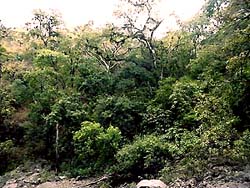 At the invitation of the Fundación Científica San Francisco (FCSF), I made a brief visit to the Zapotillo region in southwest Loja province, Ecuador, June 22-23, in the company of Eduardo Cueva and Antonio Crespo of the FCSF. The objective of this visit was to make observations of the tropical dry forests in the area, their conservation status and importance, and to make some recommendations to the FCSF regarding possible conservation activities in the region, including the acquisition of forested areas by the FCSF for establishment of a nature reserve.
At the invitation of the Fundación Científica San Francisco (FCSF), I made a brief visit to the Zapotillo region in southwest Loja province, Ecuador, June 22-23, in the company of Eduardo Cueva and Antonio Crespo of the FCSF. The objective of this visit was to make observations of the tropical dry forests in the area, their conservation status and importance, and to make some recommendations to the FCSF regarding possible conservation activities in the region, including the acquisition of forested areas by the FCSF for establishment of a nature reserve.
We visited two areas of relatively intact forest in the region northwest of the town of Zapotillo: the Quebrada Garzahuachana watershed, near the settlement of Balsa Real, and the Quebrada Tulipanes watershed, very close to the Peruvian border near the settlement of Cabeza de Toro. These areas were the sites of a "Rapid Ecological Assessment" carried out by the EcoCiencia foundation, in conjunction with the herbarium of the Universidad Nacional de Loja, in August 1999. The study included analysis of satellite imagery to create maps of vegetation and land use, and surveys of flora and fauna.
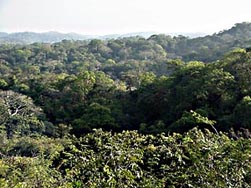 Tropical dry forests, on a worldwide basis, are one of the most threatened biomes on earth – much more so, as a whole, than tropical rain forests. The tropical lowland areas with a long dry season (more than 5 months of dry weather each year) are, in general, much more favorable for agriculture and human settlement than are the tropical rain forest areas, and they generally have much denser human populations. In the American tropics, the major regions of lowland dry forest include the Pacific coast of Central America from Mexico to Costa Rica, the Yucatan peninsula, the "caatinga" in northeastern Brazil, the "chaco" and "chiquitano" dry forest in eastern Bolivia and adjacent Argentina and Paraguay, and the Pacific coast region of Ecuador and adjacent northwestern Peru. Of these areas of dry forest, the largest area of relatively well-conserved vegetation is undoubtedly the chaco and chiquitano forest of eastern Bolivia. In Central America and Mexico, very little area of the original dry forests of the Pacific coast region remains intact. The Guanacaste National Park area in Costa Rica is well known internationally for the efforts made during the past 15 years by biologist Daniel Janzen and his Costa Rican colleagues to reforest areas in Guanacaste where the forest was removed for pasture.
Tropical dry forests, on a worldwide basis, are one of the most threatened biomes on earth – much more so, as a whole, than tropical rain forests. The tropical lowland areas with a long dry season (more than 5 months of dry weather each year) are, in general, much more favorable for agriculture and human settlement than are the tropical rain forest areas, and they generally have much denser human populations. In the American tropics, the major regions of lowland dry forest include the Pacific coast of Central America from Mexico to Costa Rica, the Yucatan peninsula, the "caatinga" in northeastern Brazil, the "chaco" and "chiquitano" dry forest in eastern Bolivia and adjacent Argentina and Paraguay, and the Pacific coast region of Ecuador and adjacent northwestern Peru. Of these areas of dry forest, the largest area of relatively well-conserved vegetation is undoubtedly the chaco and chiquitano forest of eastern Bolivia. In Central America and Mexico, very little area of the original dry forests of the Pacific coast region remains intact. The Guanacaste National Park area in Costa Rica is well known internationally for the efforts made during the past 15 years by biologist Daniel Janzen and his Costa Rican colleagues to reforest areas in Guanacaste where the forest was removed for pasture.
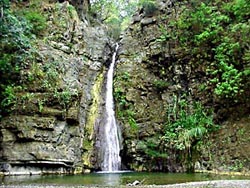 In Pacific coastal Ecuador, tropical dry forest is known mainly from the "coastal provinces" of Manabí, Guayas and El Oro. In these areas, there are very few remnants of the original dry forest vegetation remaining that have not been highly disturbed by timber extraction, grazing and agriculture. The most important reserves are Machalilla National Park in Manabí and the Bosque Protector Cerro Blanco, in Guayas province on the outskirts of the Guayaquil. In both these areas, the forest has been rather severely disturbed. The Cerro Blanco reserve is owned by the national cement company and is well managed by the Fundación Pro-Bosque. It is subject to intense pressure, however, from the population of Guayaquil. Machalilla national park is also subject to relatively intense human intervention.
In Pacific coastal Ecuador, tropical dry forest is known mainly from the "coastal provinces" of Manabí, Guayas and El Oro. In these areas, there are very few remnants of the original dry forest vegetation remaining that have not been highly disturbed by timber extraction, grazing and agriculture. The most important reserves are Machalilla National Park in Manabí and the Bosque Protector Cerro Blanco, in Guayas province on the outskirts of the Guayaquil. In both these areas, the forest has been rather severely disturbed. The Cerro Blanco reserve is owned by the national cement company and is well managed by the Fundación Pro-Bosque. It is subject to intense pressure, however, from the population of Guayaquil. Machalilla national park is also subject to relatively intense human intervention.
The lowland dry forest areas within Loja province are little known to biologists and conservationists. This is probably, in part, because Loja is considered to be an "Andean" province althought the lowland areas of southwestern Loja are biologically and geographically part of the "coastal region".
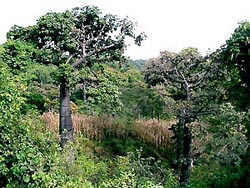 We carried out a study of the flora and vegetation of the Cerro Blanco reserve in 1997, and therefore can make some comparisons of that area with the Zapotillo area of Loja.
We carried out a study of the flora and vegetation of the Cerro Blanco reserve in 1997, and therefore can make some comparisons of that area with the Zapotillo area of Loja.
The human population density in southwestern Loja is certainly much lower than in the dry forest areas of Manabí and Guayas provinces. Probably, the soils are poorer in Loja because they are derived from older, highly weathered metamorphic rocks, whereas in Guayas and Manabí the richer soils are derived from younger volcanic and sedimentary rocks. Probably due to the poorer soils, agriculture in southwestern Loja has not been developed as much as in other coastal regions.
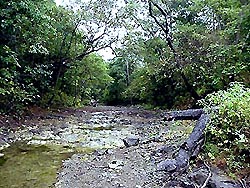 The species composition of the trees in the dry forests of the Zapotillo region is similar to that of the forests on Cerro Blanco and other areas of coastal Ecuador. The most characteristic tree of the region is the endemic "ceibo", Ceiba trichistandra, which is related to the African baobab tree, and stands out with its massive trunk, contorted limbs and green photosynthetic bark. Many of the other tree species in these forests are endemic to coastal Ecuador and adjacent Peru. I noticed that some endemic tree species which are quite rare in the Cerro Blanco area are very common in the Zapotillo area forests, including Terminalia valverdae and Cordia macrantha.
The species composition of the trees in the dry forests of the Zapotillo region is similar to that of the forests on Cerro Blanco and other areas of coastal Ecuador. The most characteristic tree of the region is the endemic "ceibo", Ceiba trichistandra, which is related to the African baobab tree, and stands out with its massive trunk, contorted limbs and green photosynthetic bark. Many of the other tree species in these forests are endemic to coastal Ecuador and adjacent Peru. I noticed that some endemic tree species which are quite rare in the Cerro Blanco area are very common in the Zapotillo area forests, including Terminalia valverdae and Cordia macrantha.
The forest areas that we visited in the Zapotillo area are much better preserved than any area that I have seen or heard of in Manabí and Guayas provinces. The upper Quebrada Garzahuachana watershed includes about 2,500 hectares of relatively undisturbed forest. Some selective logging has been carried out in this area, and severe erosion is evident along some of the abandoned logging skid trails. Domestic animals, mostly pigs and goats, have an impact on the vegetation, especially the goats which by their heavy browsing may inhibit natural regeneration of forest trees and shrubs. The condition of the Quebrada Tulipanes watershed is similar. The slopes are steeper in this area, and it evidently has not been logged.
 The areas of tropical dry forest in the Zapotillo region are not pristine wilderness, but they are almost certainly the best-preserved examples of this habitat type in western Ecuador. This region certainly merits more attention from a conservation perspective. The possible acquistion of an area of relatively intact forest for establishment of a privately owned and managed nature reserve, as contemplated by the Fundación Científica San Francisco, is one conservation action that ought to be considered very seriously. Ideally, such a reserve should include several thousand hectares, at a minimum, for a core conservation area. The reserve should be included in a more comprehensive conservation strategy for the region that includes "sustainable use" of the surrounding lands in collaboration with local landowners and inhabitants. Conservation partnerships with Peruvian organizations to include the dry forest areas just across the border, would be an important part of this initiatve.
The areas of tropical dry forest in the Zapotillo region are not pristine wilderness, but they are almost certainly the best-preserved examples of this habitat type in western Ecuador. This region certainly merits more attention from a conservation perspective. The possible acquistion of an area of relatively intact forest for establishment of a privately owned and managed nature reserve, as contemplated by the Fundación Científica San Francisco, is one conservation action that ought to be considered very seriously. Ideally, such a reserve should include several thousand hectares, at a minimum, for a core conservation area. The reserve should be included in a more comprehensive conservation strategy for the region that includes "sustainable use" of the surrounding lands in collaboration with local landowners and inhabitants. Conservation partnerships with Peruvian organizations to include the dry forest areas just across the border, would be an important part of this initiatve.

 At the invitation of the Fundación Científica San Francisco (FCSF), I made a brief visit to the Zapotillo region in southwest Loja province, Ecuador, June 22-23, in the company of Eduardo Cueva and Antonio Crespo of the FCSF. The objective of this visit was to make observations of the tropical dry forests in the area, their conservation status and importance, and to make some recommendations to the FCSF regarding possible conservation activities in the region, including the acquisition of forested areas by the FCSF for establishment of a nature reserve.
At the invitation of the Fundación Científica San Francisco (FCSF), I made a brief visit to the Zapotillo region in southwest Loja province, Ecuador, June 22-23, in the company of Eduardo Cueva and Antonio Crespo of the FCSF. The objective of this visit was to make observations of the tropical dry forests in the area, their conservation status and importance, and to make some recommendations to the FCSF regarding possible conservation activities in the region, including the acquisition of forested areas by the FCSF for establishment of a nature reserve.
 Tropical dry forests, on a worldwide basis, are one of the most threatened biomes on earth – much more so, as a whole, than tropical rain forests. The tropical lowland areas with a long dry season (more than 5 months of dry weather each year) are, in general, much more favorable for agriculture and human settlement than are the tropical rain forest areas, and they generally have much denser human populations. In the American tropics, the major regions of lowland dry forest include the Pacific coast of Central America from Mexico to Costa Rica, the Yucatan peninsula, the "caatinga" in northeastern Brazil, the "chaco" and "chiquitano" dry forest in eastern Bolivia and adjacent Argentina and Paraguay, and the Pacific coast region of Ecuador and adjacent northwestern Peru. Of these areas of dry forest, the largest area of relatively well-conserved vegetation is undoubtedly the chaco and chiquitano forest of eastern Bolivia. In Central America and Mexico, very little area of the original dry forests of the Pacific coast region remains intact. The Guanacaste National Park area in Costa Rica is well known internationally for the efforts made during the past 15 years by biologist Daniel Janzen and his Costa Rican colleagues to reforest areas in Guanacaste where the forest was removed for pasture.
Tropical dry forests, on a worldwide basis, are one of the most threatened biomes on earth – much more so, as a whole, than tropical rain forests. The tropical lowland areas with a long dry season (more than 5 months of dry weather each year) are, in general, much more favorable for agriculture and human settlement than are the tropical rain forest areas, and they generally have much denser human populations. In the American tropics, the major regions of lowland dry forest include the Pacific coast of Central America from Mexico to Costa Rica, the Yucatan peninsula, the "caatinga" in northeastern Brazil, the "chaco" and "chiquitano" dry forest in eastern Bolivia and adjacent Argentina and Paraguay, and the Pacific coast region of Ecuador and adjacent northwestern Peru. Of these areas of dry forest, the largest area of relatively well-conserved vegetation is undoubtedly the chaco and chiquitano forest of eastern Bolivia. In Central America and Mexico, very little area of the original dry forests of the Pacific coast region remains intact. The Guanacaste National Park area in Costa Rica is well known internationally for the efforts made during the past 15 years by biologist Daniel Janzen and his Costa Rican colleagues to reforest areas in Guanacaste where the forest was removed for pasture.
 In Pacific coastal Ecuador, tropical dry forest is known mainly from the "coastal provinces" of Manabí, Guayas and El Oro. In these areas, there are very few remnants of the original dry forest vegetation remaining that have not been highly disturbed by timber extraction, grazing and agriculture. The most important reserves are Machalilla National Park in Manabí and the Bosque Protector Cerro Blanco, in Guayas province on the outskirts of the Guayaquil. In both these areas, the forest has been rather severely disturbed. The Cerro Blanco reserve is owned by the national cement company and is well managed by the Fundación Pro-Bosque. It is subject to intense pressure, however, from the population of Guayaquil. Machalilla national park is also subject to relatively intense human intervention.
In Pacific coastal Ecuador, tropical dry forest is known mainly from the "coastal provinces" of Manabí, Guayas and El Oro. In these areas, there are very few remnants of the original dry forest vegetation remaining that have not been highly disturbed by timber extraction, grazing and agriculture. The most important reserves are Machalilla National Park in Manabí and the Bosque Protector Cerro Blanco, in Guayas province on the outskirts of the Guayaquil. In both these areas, the forest has been rather severely disturbed. The Cerro Blanco reserve is owned by the national cement company and is well managed by the Fundación Pro-Bosque. It is subject to intense pressure, however, from the population of Guayaquil. Machalilla national park is also subject to relatively intense human intervention.
 We carried out a study of the flora and vegetation of the Cerro Blanco reserve in 1997, and therefore can make some comparisons of that area with the Zapotillo area of Loja.
We carried out a study of the flora and vegetation of the Cerro Blanco reserve in 1997, and therefore can make some comparisons of that area with the Zapotillo area of Loja.
 The species composition of the trees in the dry forests of the Zapotillo region is similar to that of the forests on Cerro Blanco and other areas of coastal Ecuador. The most characteristic tree of the region is the endemic "ceibo", Ceiba trichistandra, which is related to the African baobab tree, and stands out with its massive trunk, contorted limbs and green photosynthetic bark. Many of the other tree species in these forests are endemic to coastal Ecuador and adjacent Peru. I noticed that some endemic tree species which are quite rare in the Cerro Blanco area are very common in the Zapotillo area forests, including Terminalia valverdae and Cordia macrantha.
The species composition of the trees in the dry forests of the Zapotillo region is similar to that of the forests on Cerro Blanco and other areas of coastal Ecuador. The most characteristic tree of the region is the endemic "ceibo", Ceiba trichistandra, which is related to the African baobab tree, and stands out with its massive trunk, contorted limbs and green photosynthetic bark. Many of the other tree species in these forests are endemic to coastal Ecuador and adjacent Peru. I noticed that some endemic tree species which are quite rare in the Cerro Blanco area are very common in the Zapotillo area forests, including Terminalia valverdae and Cordia macrantha.
 The areas of tropical dry forest in the Zapotillo region are not pristine wilderness, but they are almost certainly the best-preserved examples of this habitat type in western Ecuador. This region certainly merits more attention from a conservation perspective. The possible acquistion of an area of relatively intact forest for establishment of a privately owned and managed nature reserve, as contemplated by the Fundación Científica San Francisco, is one conservation action that ought to be considered very seriously. Ideally, such a reserve should include several thousand hectares, at a minimum, for a core conservation area. The reserve should be included in a more comprehensive conservation strategy for the region that includes "sustainable use" of the surrounding lands in collaboration with local landowners and inhabitants. Conservation partnerships with Peruvian organizations to include the dry forest areas just across the border, would be an important part of this initiatve.
The areas of tropical dry forest in the Zapotillo region are not pristine wilderness, but they are almost certainly the best-preserved examples of this habitat type in western Ecuador. This region certainly merits more attention from a conservation perspective. The possible acquistion of an area of relatively intact forest for establishment of a privately owned and managed nature reserve, as contemplated by the Fundación Científica San Francisco, is one conservation action that ought to be considered very seriously. Ideally, such a reserve should include several thousand hectares, at a minimum, for a core conservation area. The reserve should be included in a more comprehensive conservation strategy for the region that includes "sustainable use" of the surrounding lands in collaboration with local landowners and inhabitants. Conservation partnerships with Peruvian organizations to include the dry forest areas just across the border, would be an important part of this initiatve.